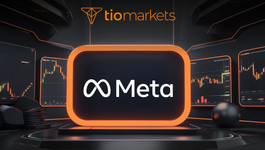Understanding Mean Reversion in Trading: How It Works | TIOmarkets
BY TIOmarkets
|June 11, 2024In the realm of Forex trading, the concept of mean reversion presents a fascinating strategy for traders aiming to capitalize on currency value fluctuations. This article delves into the intricacies of mean reversion, offering a comprehensive guide to understanding how it operates within the trading sphere.
What is Mean Reversion?
Mean reversion is a financial theory suggesting that asset prices and historical returns eventually return to the long-term mean or average level of the entire dataset. This principle is based on the assumption that high and low prices are temporary and a price will tend to move back to its average over time.
The Basics of Mean Reversion
At its core, mean reversion seeks to exploit the volatility and temporary inefficiencies in the market. Traders who employ this strategy typically look for extreme deviations in asset prices from their historical average, with the expectation that prices will revert back to that average.
Understanding the fundamental aspects of mean reversion requires recognizing that markets are not always rational and can be influenced by a myriad of factors, leading to temporary price spikes or drops. Mean reversion traders capitalize on these anomalies.
Identifying Mean Reversion Opportunities
Identifying potential mean reversion opportunities involves monitoring for significant price movements away from a historical average. Traders often use technical indicators such as the Moving Average, Bollinger Bands, or the Relative Strength Index (RSI) to detect these opportunities.
It's crucial for traders to conduct thorough analysis and not rely solely on one indicator. Combining various tools and looking for confluence can increase the probability of successful mean reversion trades.
Additional Considerations in Identifying Opportunities
When looking for mean reversion opportunities, traders should also consider the broader market context. Factors such as economic indicators, geopolitical events, and central bank policies can all influence price movements and impact the effectiveness of mean reversion strategies.
Moreover, understanding the correlation between different assets and how they react to market conditions can provide valuable insights for identifying potential mean reversion opportunities across multiple markets.
By incorporating a holistic approach to market analysis, traders can enhance their ability to pinpoint optimal entry and exit points for mean reversion trades.
Implementing Mean Reversion in Trading
Implementing a mean reversion strategy requires a disciplined approach and an understanding of the market's inherent volatility. Traders must be prepared to act swiftly when they identify a trading opportunity and also know when to exit a trade.
Setting Up Trades
Setting up a mean reversion trade involves identifying an asset that has deviated significantly from its historical average and determining an entry point. Traders often set entry points near recent lows for buying opportunities or near recent highs for selling opportunities.
It's essential to consider the size of the deviation from the mean. Small deviations might not offer sufficient profit potential to justify the risk, whereas larger deviations can provide more attractive trading opportunities.
Risk Management
Risk management is a critical component of any trading strategy, but it's especially important in mean reversion trading due to the potential for sudden price movements against the trade. Traders should employ stop-loss orders to limit potential losses and regularly review their positions to adjust their risk exposure.
Additionally, diversifying across different assets and not overleveraging on a single trade can help manage the overall risk in a trading portfolio.
Psychological Aspects of Mean Reversion Trading
Successful mean reversion trading also involves managing psychological factors that can impact decision-making. Traders need to maintain discipline, patience, and emotional control to avoid impulsive actions driven by fear or greed.
Developing a trading plan with clear entry and exit rules, as well as predefined risk management strategies, can help traders navigate the psychological challenges of mean reversion trading and stay focused on their long-term goals.
Pros and Cons of Mean Reversion Trading
Like any trading strategy, mean reversion comes with its own set of advantages and challenges. Understanding these can help traders make informed decisions about incorporating mean reversion into their trading arsenal.
Advantages
- Profit Opportunities: Mean reversion can offer significant profit opportunities from price corrections.
- Applicability: This strategy can be applied across various asset classes, including Forex, stocks, and commodities.
- Market Conditions: Mean reversion strategies can perform well in both volatile and stable market conditions.
Challenges
- Timing: Identifying the optimal entry and exit points requires precision, and mistiming can lead to losses.
- Market Extremes: Extreme market events can cause prices to deviate from the mean for extended periods, challenging the assumption of mean reversion.
- Risk Management: Effective risk management is crucial to mitigate potential losses from unexpected market movements.
Conclusion
Mean reversion trading offers a strategic approach for traders looking to exploit temporary price inefficiencies in the market. While it presents opportunities for profit, it also requires a disciplined approach to risk management and a thorough understanding of market dynamics. As with any trading strategy, success in mean reversion trading comes from consistent application, continuous learning, and adapting to changing market conditions.
At TIOmarkets, we provide traders with the tools and resources needed to explore various trading strategies, including mean reversion. Our platform offers a robust trading environment where traders can apply, test, and refine their trading approaches in the pursuit of their financial goals.
Start Your Mean Reversion Trading Journey with TIOmarkets
Ready to put mean reversion strategies into action? Join the 170,000+ traders in over 170 countries who have chosen TIOmarkets as their trusted forex broker. With access to over 300 instruments across 5 markets, our low-fee online trading platform is designed to help you trade Forex, indices, stocks, commodities, and futures markets effectively. Enhance your trading skills with our comprehensive suite of educational resources and step-by-step guides. Take the first step towards mastering mean reversion trading by creating a trading account with TIOmarkets today.

Risk disclaimer: CFDs are complex instruments and come with a high risk of losing money rapidly due to leverage. You should consider whether you understand how CFDs work and whether you can afford to take the high risk of losing your money. Never deposit more than you are prepared to lose. Professional client’s losses can exceed their deposit. Please see our risk warning policy and seek independent professional advice if you do not fully understand. This information is not directed or intended for distribution to or use by residents of certain countries/jurisdictions including, but not limited to, USA & OFAC. The Company holds the right to alter the aforementioned list of countries at its own discretion.
Join us on social media

Behind every blog post lies the combined experience of the people working at TIOmarkets. We are a team of dedicated industry professionals and financial markets enthusiasts committed to providing you with trading education and financial markets commentary. Our goal is to help empower you with the knowledge you need to trade in the markets effectively.
Related Posts





